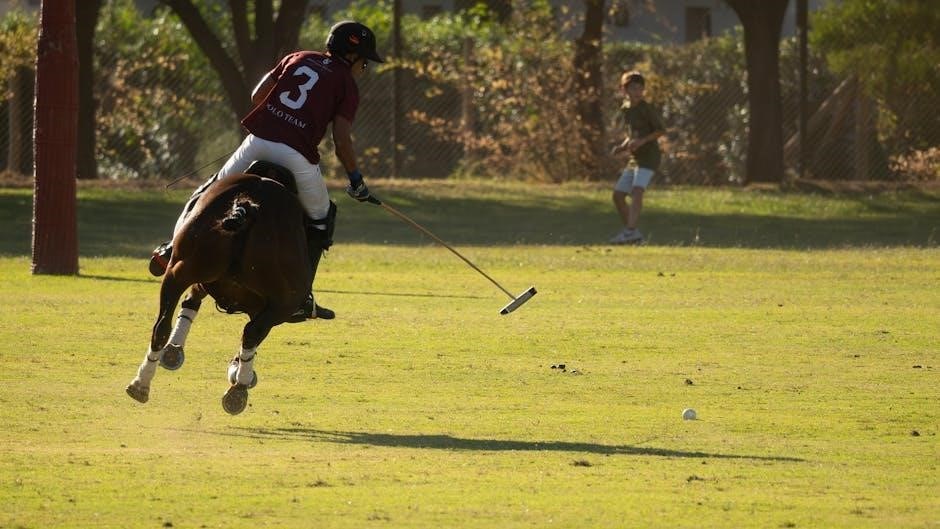After undergoing the Epley maneuver, patients must follow specific guidelines to ensure proper recovery and prevent vertigo recurrence. These instructions emphasize rest, activity avoidance, and symptom monitoring.
What is the Epley Maneuver?
The Epley maneuver is a non-invasive, effective treatment for Benign Paroxysmal Positional Vertigo (BPPV). It involves a series of specific head movements designed to relocate calcium crystals (otoconia) from the utricle to the semicircular canals, where they no longer cause vertigo. Performed by healthcare professionals, this technique is often recommended for patients experiencing persistent dizziness or imbalance. The maneuver is typically painless and can significantly reduce or eliminate BPPV symptoms in a single session. In some cases, patients may also be taught to perform a modified version at home under medical guidance. Its success relies on accurate diagnosis and proper execution.
Importance of Following Post-Maneuver Instructions
Importance of Following Post-Maneuver Instructions
Adhering to post-Epley maneuver instructions is crucial for effective recovery and preventing vertigo recurrence. Proper rest, avoiding strenuous activities, and monitoring symptoms ensure the crystals remain stable. Ignoring guidelines may dislodge crystals, causing dizziness. Following instructions maximizes treatment success, reduces recovery time, and minimizes complications. Patients must prioritize these steps to achieve long-term relief and vestibular health. Compliance ensures the Epley maneuver’s effectiveness and helps avoid further medical interventions. By carefully following post-procedure care, individuals can resume normal activities safely and maintain balance. These instructions are tailored to promote healing and prevent setbacks, making adherence essential for optimal outcomes.

Immediate Post-Maneuver Care
After the Epley maneuver, rest for 10 minutes before leaving. Avoid sudden head movements and strenuous activities for 24 hours. Do not drive immediately post-procedure.
Waiting Period Before Resuming Normal Activities
Patients should wait 24 hours before resuming normal activities to allow the crystals to settle. Avoid bending, heavy lifting, or quick head movements during this period. Rest is crucial for recovery and preventing vertigo recurrence. Gentle movements are permissible, but activities requiring intense physical exertion should be avoided. This waiting period ensures the Epley maneuver’s effectiveness and reduces the risk of dislodging the crystals again. Adhering to this guideline helps in achieving a smoother and more sustainable recovery from BPPV symptoms.
Avoiding Strenuous Activities
Avoiding Strenuous Activities
Avoiding strenuous activities is crucial after the Epley maneuver to prevent dislodging the otoliths. Heavy lifting, bending, or intense exercises can disrupt the crystals’ settling process. Patients should refrain from activities that involve rapid head movements or straining. Even simple tasks like reaching high shelves or twisting should be minimized. By limiting physical exertion, individuals reduce the risk of vertigo recurrence and promote a more stable recovery. This precautionary measure ensures the maneuver’s effectiveness and supports long-term relief from BPPV symptoms. Gentle activities are encouraged, but anything that strains the body should be postponed until advised otherwise by a healthcare provider.
Monitoring for Dizziness or Discomfort
Monitoring for Dizziness or Discomfort
After the Epley maneuver, it’s essential to monitor for any signs of dizziness or discomfort. Patients should be aware of mild dizziness or imbalance, which may occur temporarily. If severe vertigo or nausea persists, it’s crucial to rest and avoid sudden movements. Lying down in a quiet, dark room can help alleviate symptoms. Keep track of any recurring episodes, as this may indicate the need for further treatment. Monitoring ensures early detection of any issues and helps in adjusting recovery strategies. Patients should not hesitate to seek medical advice if discomfort worsens or lasts beyond the expected period, typically 48 hours post-procedure.
Home Care and Restrictions
After the Epley maneuver, patients should avoid head movements, use supportive pillows, and elevate their head while sleeping. Avoid heavy lifting and strenuous activities during recovery.
Recommended Sleep Position
Sleeping position plays a crucial role in post-Epley maneuver recovery. Patients are advised to sleep on a firm mattress and use a cervical pillow to support the neck. Elevating the head of the bed by 30-45 degrees using extra pillows can help prevent calcium crystals from moving. Avoid sleeping on the side of the treated ear for at least 48 hours. If dizziness occurs during sleep, remain still and wait for symptoms to subside before moving. Proper sleep positioning aids in keeping crystals in stable areas of the inner ear, promoting better recovery and reducing vertigo episodes.
Avoiding Certain Head Movements
After the Epley maneuver, it’s essential to avoid specific head movements to prevent dislodging the calcium crystals. Patients should refrain from tipping their head backward, sudden turns, and bending over. Avoid activities like looking upward or downward sharply, as these can disrupt the crystals’ stability. For the first 48 hours, keep the head in a neutral position to allow crystals to settle. If dizziness occurs during these movements, stop immediately and remain still until symptoms subside. By limiting head movements, patients can reduce the risk of vertigo recurrence and support the healing process.
Use of Supportive Devices
After the Epley maneuver, patients may benefit from using supportive devices to aid recovery. A cervical collar or neck brace can help limit excessive head movements, reducing the risk of displacing the calcium crystals. These devices provide stability and remind patients to avoid sudden motions. Additionally, some patients find comfort using pillows or rolled towels to support their neck while sleeping. However, these devices should only be used as recommended by a healthcare provider. They are temporary aids to promote healing and prevent vertigo recurrence. Always follow specific guidance to ensure proper use and maximize recovery benefits.

Managing Symptoms Post-Maneuver
After the Epley maneuver, some patients may experience residual dizziness or mild discomfort. Monitoring these symptoms is crucial for assessing treatment effectiveness and determining if further intervention is needed.
Handling Residual Dizziness
Sometime after the Epley maneuver, patients might still experience mild dizziness or imbalance. It is important to rest and avoid sudden head movements to allow the inner ear to recover. Staying hydrated and avoiding strenuous activities can help reduce symptoms. If dizziness persists, over-the-counter anti-nausea medications may be recommended. Patients should also avoid sleeping on the affected side to prevent dislodging the calcium crystals. Monitoring the severity of dizziness is crucial, as worsening symptoms may indicate the need for further evaluation or repeated treatment. Consulting a healthcare provider if dizziness lasts beyond a few days is advisable to ensure proper recovery;
Exercises to Aid Recovery
After the Epley maneuver, gentle exercises can help restore balance and reduce symptoms. The Brandt-Daroff exercises are often recommended to improve vestibular function. Patients should start with short sessions, resting between repetitions to avoid exacerbating dizziness. Vestibular rehabilitation exercises, such as eye movements and head rotations, can also aid recovery. It is important to perform these exercises slowly and carefully to prevent dislodging the calcium crystals; Consistency is key, but patients should not overexert themselves. If symptoms persist or worsen, consulting a healthcare provider for further guidance is essential to ensure proper healing and prevent recurrence of vertigo episodes.

Follow-Up Care
After the Epley maneuver, follow-up appointments are crucial to monitor recovery and repeat tests like the Dix-Hallpike to ensure vertigo symptoms have resolved, and to continue vestibular exercises as needed.
When to See a Doctor
If you experience persistent dizziness, severe headaches, or nausea after the Epley maneuver, seek medical attention immediately. If symptoms worsen or last beyond a few days, consult your doctor. Persistent vertigo, hearing loss, or severe imbalance are red flags requiring evaluation. If the Epley maneuver was unsuccessful or symptoms recur, further testing, like the Dix-Hallpike test, may be needed. Your doctor can assess vestibular function and recommend additional treatments or exercises. Early intervention is key to preventing long-term issues and ensuring proper recovery from BPPV.
Post-Maneuver Testing and Evaluation
After the Epley maneuver, your doctor may perform the Dix-Hallpike test to assess vertigo symptoms and confirm improvement. This test involves specific head movements to check for nystagmus or dizziness. Follow-up appointments are crucial to monitor recovery and rule out persistent vestibular issues. If symptoms remain or worsen, additional testing, such as electronystagmography or videonystagmography, may be recommended. These evaluations help determine if further treatment or exercises are needed. Regular check-ups ensure proper healing and prevent complications. If symptoms persist, your doctor may explore other causes or adjust treatment plans accordingly.

Long-Term Care and Prevention
Regular balance exercises and lifestyle adjustments help prevent BPPV recurrence. Patients should avoid triggers, maintain a healthy diet, and stay hydrated to support vestibular health long-term.
Preventing Recurrence of BPPV
Preventing BPPV recurrence involves lifestyle adjustments and avoiding triggers. Patients should steer clear of abrupt head movements, heavy lifting, and prolonged periods in positions that may dislodge crystals. Regular balance exercises and staying hydrated can aid vestibular health. Managing stress and avoiding excessive screen time may also reduce symptoms. Using supportive pillows and devices can help maintain proper head positioning during sleep. Patients are encouraged to perform the home Epley maneuver if symptoms briefly return. Regular follow-ups with a healthcare provider ensure long-term stability. Adherence to these guidelines significantly lowers the likelihood of BPPV returning, promoting overall vestibular well-being and reducing vertigo episodes.
Maintaining Balance and Vestibular Health
Maintaining Balance and Vestibular Health
Maintaining balance and vestibular health post-Epley maneuver requires consistent effort and awareness. Patients should engage in gentle exercises like tai chi or yoga to improve stability. Avoiding extreme head positions during daily activities, such as bending or looking up, is crucial. Using supportive devices like canes or walking aids can prevent falls. Staying hydrated and managing stress through relaxation techniques also supports vestibular function. Regular practice of vestibular rehabilitation exercises, as recommended by a healthcare provider, can enhance balance and reduce dizziness. Over time, these habits help restore equilibrium and minimize the risk of future episodes, promoting long-term vestibular health and overall well-being.
Adhering to post-Epley instructions ensures effective recovery and balance restoration, minimizing vertigo recurrence and promoting long-term vestibular health through proper care and mindful daily practices.
Key Takeaways for Patients
Patients should prioritize adherence to post-Epley instructions to prevent complications and ensure optimal recovery. Key points include waiting 10 minutes before leaving, avoiding strenuous activities for 24 hours, and monitoring for dizziness. Sleeping upright for 48 hours and avoiding head movements that trigger vertigo are crucial. Using supportive devices like pillows can aid comfort. Patients should follow recommended exercises and schedule follow-ups to confirm recovery. Recognizing when to seek medical help, such as worsening symptoms, is vital. Consistent adherence to these guidelines enhances vestibular health and reduces BPPV recurrence risk, ensuring a smoother and safer recovery process.
Importance of Adherence to Instructions
Importance of Adherence to Instructions
Adhering to post-Epley maneuver instructions is crucial for maximizing treatment effectiveness and minimizing complications. Proper adherence ensures the calcium crystals remain in stable positions, reducing the risk of vertigo recurrence. Non-compliance may lead to displaced crystals, causing symptoms to persist or worsen. Following guidelines helps prevent unnecessary discomfort and accelerates recovery. Patients who adhere to instructions typically experience fewer residual symptoms and achieve better long-term vestibular health. Consistency in following care instructions demonstrates a proactive approach to recovery, ensuring the Epley maneuver’s success and promoting overall well-being.
